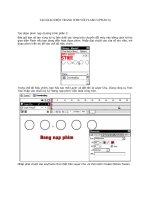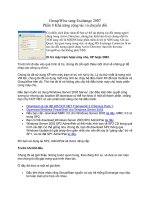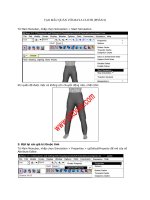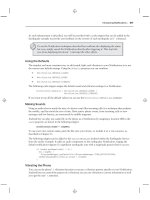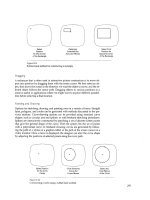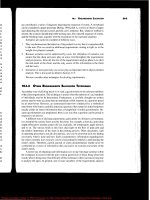netscreen concepts examples vpns phần 8 ppt
Bạn đang xem bản rút gọn của tài liệu. Xem và tải ngay bản đầy đủ của tài liệu tại đây (335.3 KB, 27 trang )
&KDSWHU3ROLF\%DVHG931V 'LDOXSWR/$1931V
1HW6FUHHQ&RQFHSWV([DPSOHV²9ROXPH931V
9. Click Authentication (Phase 1) > Proposal 1: Select the following Encryption and Data Integrity
Algorithms:
Encrypt Alg: Triple DES
Hash Alg: SHA-1
Key Group: Diffie-Hellman Group 2
10. Click Key Exchange (Phase 2) > Proposal 1: Select the following IPSec Protocols:
Encapsulation Protocol (ESP): (select)
Encrypt Alg: Triple DES
Hash Alg: SHA-1
Encapsulation: Tunnel
11. Click Key Exchange (Phase 2) > Create New Proposal: Select the following IPSec Protocols:
Encapsulation Protocol (ESP): (select)
Encrypt Alg: Triple DES
Hash Alg: MD5
Encapsulation: Tunnel
12. Click Key Exchange (Phase 2) > Create New Proposal: Select the following IPSec Protocols:
Encapsulation Protocol (ESP): (select)
Encrypt Alg: DES
Hash Alg: SHA-1
Encapsulation: Tunnel
13. Click Key Exchange (Phase 2) > Create New Proposal: Select the following IPSec Protocols:
Encapsulation Protocol (ESP): (select)
Encrypt Alg: DES
Hash Alg: MD5
Encapsulation: Tunnel
14. Click Save.
&KDSWHU3ROLF\%DVHG931V *URXS,.(,'
1HW6FUHHQ&RQFHSWV([DPSOHV²9ROXPH931V
*5283,.(,'
Some organizations have many dialup VPN users. For example, a sales department might have hundreds of users,
many of whom require secure dialup-to-LAN communication when off site. With so many users, it is impractical to
create a separate user definition, dialup-to-LAN VPN configuration, and policy for each one.
To avoid this difficulty, the Group IKE ID method makes one user definition available for multiple users. The group
IKE ID user definition applies to all users having certificates with specified values in the distinguished name (dn) or
to all users whose full IKE ID and preshared key on their VPN client match a partial IKE ID and preshared key on the
NetScreen device.
You add a single group IKE ID user to an IKE dialup VPN user group and specify the maximum number of
concurrent connections that that group supports. The maximum number of concurrent sessions cannot exceed the
maximum number of allowed Phase 1 SAs or the maximum number of VPN tunnels allowed on the NetScreen
platform.
Note: When a dialup IKE user connects to the NetScreen device, the NetScreen device first extracts and uses the
full IKE ID to search its peer gateway records in case the user does not belong to a group IKE ID user group. If the
full IKE ID search produces no matching entry, the NetScreen device then checks for a partial IKE ID match
between the incoming embedded IKE ID and a configured group IKE ID user.
&KDSWHU3ROLF\%DVHG931V *URXS,.(,'
1HW6FUHHQ&RQFHSWV([DPSOHV²9ROXPH931V
*URXS,.(,'ZLWK&HUWLILFDWHV
Group IKE ID with certificates is a technique for performing IKE authentication for a group of dialup IKE users
without configuring a separate user profile for each one. Instead, the NetScreen device uses a single group IKE ID
user profile that contains a partial IKE ID. A dialup IKE user can successfully build a VPN tunnel to a NetScreen
device if the VPN configuration on his VPN client specifies a certificate that contains distinguished name elements
that match those configured as the partial IKE ID definition in the group IKE ID user profile on the NetScreen device.
Full IKE ID
(distinguished name)
Certificate
DN:
cn=alice
ou=eng
3
3
2
Group IKE ID User
ASN1-DN IKE ID Type
Partial IKE ID: ou=eng
To authenticate the user, NetScreen compares
a specific element of the distinguished name
(dn) associated with the dialup user group with
the corresponding element in the certificate
and the dn used for the IKE ID payload
accompanying the initial Phase 1 packet.
Dialup User Group
Note: Because the distinguished
name in Carol’s certificate does
not include ou=eng, NetScreen
rejects the connection request.
Dialup IKE Users
Group IKE ID with Certificates
Certificate
DN:
cn=bob
ou=eng
Certificate
DN:
cn=carol
ou=sales
&KDSWHU3ROLF\%DVHG931V *URXS,.(,'
1HW6FUHHQ&RQFHSWV([DPSOHV²9ROXPH931V
You can set up group IKE ID with certificates as follows:
2QWKH1HW6FUHHQ'HYLFH
1. Create a new group IKE ID user with a partial IKE identity (such as ou=sales,o=netscreen), and specify how
many dialup users can use the group IKE ID profile to log on.
2. Assign the new group IKE ID user to a dialup user group
16
, and name the group.
3. In the dialup-to-LAN AutoKey IKE VPN configuration, specify the name of the dialup user group, that the
Phase 1 negotiations be in Aggressive mode, and that certificates (RSA or DSA, depending on the type of
certificate loaded on the dialup VPN clients) be used for authentication.
4. Create a policy permitting inbound traffic via the specified dialup VPN.
2QWKH931&OLHQW
1. Obtain and load a certificate whose distinguished name contains the same information as defined in the
partial IKE ID on the NetScreen device.
2. Configure a VPN tunnel to the NetScreen device using Aggressive mode for Phase 1 negotiations, specify
the certificate that you have previously loaded, and select Distinguished Name for the local IKE ID type.
Thereafter, each individual dialup IKE user with a certificate with distinguished name elements that match the partial
IKE ID defined in the group IKE ID user profile can successfully build a VPN tunnel to the NetScreen device. For
example, if the group IKE ID user has IKE ID OU=sales,O=netscreen, the NetScreen device accepts Phase 1
negotiations from any user with a certificate containing those elements in its distinguished name. The maximum
number of such dialup IKE users that can connect to the NetScreen device depends upon the maximum number of
concurrent sessions that you specify in the group IKE ID user profile.
16. You can put only one group IKE ID user in an IKE user group.
&KDSWHU3ROLF\%DVHG931V *URXS,.(,'
1HW6FUHHQ&RQFHSWV([DPSOHV²9ROXPH931V
:LOGFDUGDQG&RQWDLQHU$61'1,.(,'7\SHV
When you define the IKE ID for a group IKE user, you must use the Abstract Syntax Notation, version 1,
distinguished name (ASN1-DN) as the IKE ID type of identity configuration. This notation is a string of values, which
are frequently, though not always, ordered from general to specific. For example:
When configuring the group IKE ID user, you must specify the peer’s ASN1-DN ID as one of two types:
• Wildcard: NetScreen authenticates a dialup IKE user’s ID if the values in the dialup IKE user’s ASN1-DN
identity fields match those in the group IKE user’s ASN1-DN identity fields. The wildcard ID type supports
only one value per identity field (for example, “ou=eng” or “ou=sw”, but not “ou=eng,ou=sw”). The ordering
of the identity fields in the two ASN1-DN strings is inconsequential.
• Container: NetScreen authenticates a dialup IKE user’s ID if the values in the dialup IKE user’s ASN1-DN
identity fields exactly match the values in the group IKE user’s ASN1-DN identity fields. The container ID
type supports multiple entries for each identity field (for example, “ou=eng,ou=sw,ou=screenos”). The
ordering of the values in the identity fields of the two ASN1-DN strings must be identical.
C=us
Legend:
C = Country
ST = State
L = Locality
O = Organization
OU = Organizational Unit
CN = Common Name
ST=ca
L=sunnyvale
O=netscreen
OU=sales
CN=joe
General
Specific
ASN1-DN: C=us,ST=ca,L=sunnyvale,O=netscreen,OU=sales,CN=joe
&KDSWHU3ROLF\%DVHG931V *URXS,.(,'
1HW6FUHHQ&RQFHSWV([DPSOHV²9ROXPH931V
:LOGFDUG$61'1,.(,'
A wildcard ASN1-DN requires values in the remote peer’s distinguished name IKE ID to match values in the group
IKE user’s partial ASN1-DN IKE ID. The sequencing of these values in the ASN1-DN string is inconsequential. For
example, if the dialup IKE user’s ID and the group IKE user’s ID are as follows
• Dialup IKE user’s full ASN1-DN IKE ID: CN=christine,OU=finance,O=netscreen,ST=ca,C=us
• Group IKE user’s partial ASN1-DN IKE ID: C=us,O=netscreen
then a wildcard ASN1-DN IKE ID successfully matches the two IKE IDs, even though the order of values in the two
IDs is different.
E=
CN=christine
OU=finance
O=netscreen
L=
ST=ca
C=us
E=
C=us
ST=
L=
O=netscreen
OU=
CN=
Dialup IKE User’s
ASN1-DN IKE ID
Group IKE User’s wildcard
ASN1-DN IKE ID
3
Authentication
The dialup IKE user’s ASN1-DN
contains the values specified in the
group IKE user’s ASN1-DN. The
order of the values does not matter.
&KDSWHU3ROLF\%DVHG931V *URXS,.(,'
1HW6FUHHQ&RQFHSWV([DPSOHV²9ROXPH931V
&RQWDLQHU$61'1,.(,'
A container ASN1-DN ID allows the group IKE user’s ID to have multiple entries in each identity field. NetScreen
authenticates a dialup IKE user if the dialup user’s ID contains values that exactly match the values in the group IKE
user’s ID. Unlike the wildcard type, the order of the ASN1-DN fields must be identical in both the dialup IKE user’s
and group IKE user’s IDs and the order of multiple values in those fields must be identical.
The second dialup IKE user’s
ASN1-DN contains exact
matches of the group IKE
user’s ASN1-DN. However, the
order of the multiple entries in
the OU ID field is not identical.
E=
C=us
ST=
L=
O=netscreen
OU=mkt,OU=dom,OU=west
CN=
Dialup IKE User’s
ASN1-DN IKE ID
Group IKE User’s container
ASN1-DN IKE ID
3
Authentication
The first dialup IKE user’s
ASN1-DN contains exact
matches of the group IKE
user’s ASN1-DN. The order of
the multiple entries in the OU
ID field is also identical.
E=
C=us
ST=ca
L= sf
O=netscreen
OU=mkt,OU=dom,OU=west
CN=yuki
E=
C=us
ST=
L=
O=netscreen
OU=mkt,OU=dom,OU=west
CN=
Dialup IKE User’s
ASN1-DN IKE ID
Group IKE User’s container
ASN1-DN IKE ID
Authentication
E=
C=us
ST=ca
L= la
O=netscreen
OU=mkt,OU=west,OU=dom
CN=joe
2
&KDSWHU3ROLF\%DVHG931V *URXS,.(,'
1HW6FUHHQ&RQFHSWV([DPSOHV²9ROXPH931V
([DPSOH*URXS,.(,'&HUWLILFDWHV
In this example, you create a new group IKE ID user definition named User1. You configure it to accept up to 10
Phase 1 negotiations concurrently from VPN clients with RSA certificates containing O=netscreen and
OU=marketing. The certificate authority (CA) is Verisign. You name the dialup IKE user group office_1.
The dialup IKE users send a distinguished name as their IKE ID. The distinguished name (dn) in a certificate for a
dialup IKE user in this group might appear as the following concatenated string:
C=us,ST=ca,L=sunnyvale,O=netscreen,OU=marketing,CN=michael zhang,CN=a2010002,CN=ns500,
CN=4085557800,CN=rsa-key,CN=10.10.5.44
Because the values O=netscreen and OU=marketing appear in the peer’s certificate and the user uses the
distinguished name as its IKE ID type, the NetScreen device authenticates the user.
For the Phase 1 and 2 security levels, you specify one Phase 1 proposal—rsa-g2-3des-sha for certificates—and
select the predefined “Compatible” set of proposals for Phase 2.
You configure a dialup-to-LAN VPN and a policy permitting HTTP traffic via the VPN tunnel to reach the Web server
Web1. The configuration of the remote VPN client (using NetScreen-Remote) is also included.
Outgoing Interface
Untrust Zone
eth3, 210.1.1.1/24
Trust Zone
eth1, 10.1.1.1/24
NAT Mode
Dialup User with
IKE ID:
o=netscreen
ou=marketing
web1
10.1.1.5
gateway 210.1.1.2
Untrust Zone
Trust Zone
VPN Tunnel
Group IKE ID User Profile
User Name: User1
User Group: office_1
Distinguished Name:
o=netscreen
ou=marketing
&KDSWHU3ROLF\%DVHG931V *URXS,.(,'
1HW6FUHHQ&RQFHSWV([DPSOHV²9ROXPH931V
:HE8,
,QWHUIDFHV²6HFXULW\=RQHV
1. Network > Interfaces > Edit (for ethernet1): Enter the following, and then click OK:
Zone Name: Trust
IP Address/Netmask: 10.1.1.1/24
2. Network > Interfaces > Edit (for ethernet3): Enter the following, and then click OK:
Zone Name: Untrust
IP Address/Netmask: 210.1.1.1/24
$GGUHVV
3. Objects > Addresses > List > New: Enter the following, and then click OK:
Address Name: web1
IP Address/Domain Name:
IP/Netmask: (select), 10.1.1.5/32
Zone: Trust
8VHUV
4. Objects > User Groups > Local > New: Enter the following, and then click OK:
Group Name: office_1
5. Objects > Users > Local > New: Enter the following, then click OK:
User Name: User1
User Group: office_1
Status Enable: (select)
IKE User: (select)
&KDSWHU3ROLF\%DVHG931V *URXS,.(,'
1HW6FUHHQ&RQFHSWV([DPSOHV²9ROXPH931V
Number of Multiple Logins with same ID: 10
Use Distinguished Name For ID: (select)
OU: marketing
Organization: netscreen
931
6. VPNs > AutoKey Advanced > Gateway > New: Enter the following, and then click OK:
Gateway Name: Corp_GW
Security Level: Custom
Remote Gateway Type: Dialup User Group: (select), Group: office_1
Outgoing Interface: ethernet3
> Advanced: Enter the following advanced settings, and then click Return to
return to the basic Gateway configuration page:
Security Level: Custom
Phase 1 Proposal (For Custom Security Level):
rsa-g2-3des-sha
Mode (Initiator): Aggressive
Preferred Certificate (optional):
Peer CA: Verisign
Peer Type: X509-SIG
7. VPNs > AutoKey IKE > New: Enter the following, and then click OK:
VPN Name: Corp_VPN
Security Level: Compatible
Remote Gateway: Predefined: (select), Corp_GW
&KDSWHU3ROLF\%DVHG931V *URXS,.(,'
1HW6FUHHQ&RQFHSWV([DPSOHV²9ROXPH931V
5RXWH
8. Network > Routing > Routing Table > trust-vr New: Enter the following, and then click OK:
Network Address/Netmask: 0.0.0.0/0
Gateway: (select)
Interface: ethernet3(untrust)
Gateway IP Address: 210.1.1.2
3ROLF\
9. Policies > (From: Untrust, To: Trust) New: Enter the following, and then click OK:
Source Address:
Address Book: (select), Dial-Up VPN
Destination Address:
Address Book: (select), web1
Service: HTTP
Action: Tunnel
Tunnel VPN: Corp_VPN
Modify matching VPN policy: (clear)
Position at Top: (select)
&KDSWHU3ROLF\%DVHG931V *URXS,.(,'
1HW6FUHHQ&RQFHSWV([DPSOHV²9ROXPH931V
&/,
,QWHUIDFHV²6HFXULW\=RQHV
1. set interface ethernet1 zone trust
2. set interface ethernet1 ip 10.1.1.1/24
3. set interface ethernet3 zone untrust
4. set interface ethernet3 ip 210.1.1.1/24
$GGUHVV
5. set address trust web1 10.1.1.5/32
8VHUV
6. set user User1 ike-id asn1-dn wildcard o=netscreen,ou=marketing share-limit 10
7. set dialup-group office_1 + User1
931
8. set ike gateway Corp_GW dialup office_1 aggressive outgoing-interface ethernet3 proposal
rsa-g2-3des-sha
9. set ike gateway Corp_GW cert peer-ca 1
17
10. set ike gateway Corp_GW cert peer-cert-type x509-sig
11. set vpn Corp_VPN gateway Corp_GW sec-level compatible
3ROLF\
12. set policy top from untrust to trust “Dial-Up VPN” web1 http tunnel vpn-dialup Corp_VPN
13. save
17. The number 1 is the CA ID number. To discover the CA’s ID number, use the following command: get pki x509 list ca-cert.
&KDSWHU3ROLF\%DVHG931V *URXS,.(,'
1HW6FUHHQ&RQFHSWV([DPSOHV²9ROXPH931V
1HW6FUHHQ5HPRWH6HFXULW\3ROLF\(GLWRU
1. Click Options > Secure > Specified Connections.
2. Click Add a new connection, and type web1 next to the new connection icon that appears.
3. Configure the connection options:
Connection Security: Secure
Remote Party ID Type: IP Address
IP Address: 10.1.1.5
Connect using Secure Gateway Tunnel: (select)
ID Type: IP Address; 210.1.1.1
4. Click the PLUS symbol, located to the left of the web1 icon, to expand the connection policy.
5. Click My Identity: Select the certificate that has o=netscreen,ou=marketing as elements in its distinguished
name from the Select Certificate drop-down list
18
.
ID Type: Select Distinguished Name from the drop-down list.
6. Click the Security Policy icon, and select Aggressive Mode.
7. Click the PLUS symbol, located to the left of the Security Policy icon, and then the PLUS symbol to the left
of Authentication (Phase 1) and Key Exchange (Phase 2) to expand the policy further.
8. Click Authentication (Phase 1) > Proposal 1: Select the following Encryption and Data Integrity
Algorithms:
Authentication Method: RSA Signatures
Encrypt Alg: Triple DES
Hash Alg: SHA-1
Key Group: Diffie-Hellman Group 2
18. This example assumes that you have already loaded a suitable certificate on the NetScreen-Remote client. For information on loading certificates on the
NetScreen-Remote, refer to NetScreen-Remote documentation.
&KDSWHU3ROLF\%DVHG931V *URXS,.(,'
1HW6FUHHQ&RQFHSWV([DPSOHV²9ROXPH931V
9. Click Key Exchange (Phase 2) > Proposal 1: Select the following IPSec Protocols:
Encapsulation Protocol (ESP): (select)
Encrypt Alg: Triple DES
Hash Alg: SHA-1
Encapsulation: Tunnel
10. Click Key Exchange (Phase 2) > Create New Proposal: Select the following IPSec Protocols:
Encapsulation Protocol (ESP): (select)
Encrypt Alg: Triple DES
Hash Alg: MD5
Encapsulation: Tunnel
11. Click Key Exchange (Phase 2) > Create New Proposal: Select the following IPSec Protocols:
Encapsulation Protocol (ESP): (select)
Encrypt Alg: DES
Hash Alg: SHA-1
Encapsulation: Tunnel
12. Click Key Exchange (Phase 2) > Create New Proposal: Select the following IPSec Protocols:
Encapsulation Protocol (ESP): (select)
Encrypt Alg: DES
Hash Alg: MD5
Encapsulation: Tunnel
13. Click Save.
&KDSWHU3ROLF\%DVHG931V *URXS,.(,'
1HW6FUHHQ&RQFHSWV([DPSOHV²9ROXPH931V
*URXS,.(,'ZLWK3UHVKDUHG.H\V
Group IKE ID with preshared keys is a technique for performing IKE authentication for a group of dialup IKE users
without configuring a separate user profile for each one. Instead, the NetScreen device uses a single group IKE ID
user profile, which contains a partial IKE ID. A dialup IKE user can successfully build a VPN tunnel to a NetScreen
device if the VPN configuration on his VPN client has the correct preshared key and if the rightmost part of the user’s
full IKE ID matches the group IKE ID user profile’s partial IKE ID.
The IKE ID type that you can use for the Group IKE ID with Preshared Key feature can be either an e-mail address
or a fully qualified domain name (FQDN).
Full IKE ID
+
Preshared Key
alice.eng.ns.com
+
011fg3322eda837c
bob.eng.ns.com
+
bba7e22561c5da82
carol.ns.com
+
834a2bbd32adc4e9
3
3
2
Group IKE ID User
Partial IKE ID: eng.ns.com
Preshared Key Seed Value: N11wWd2
NetScreen generates a preshared key on the
fly when an IKE user sends his full IKE ID.
(The preshared key for each IKE user =
preshared key seed value x full IKE ID.)
NetScreen compares its generated key with
the preshared key accompanying the initial
Phase 1 packet to authenticate the user.
Dialup User Group
Note: Because the IKE ID for Carol is
not carol.eng.ns.com, NetScreen
rejects the connection request.
Dialup IKE Users
Group IKE ID with Preshared Keys
&KDSWHU3ROLF\%DVHG931V *URXS,.(,'
1HW6FUHHQ&RQFHSWV([DPSOHV²9ROXPH931V
You can set up group IKE ID with preshared keys as follows:
2QWKH1HW6FUHHQ'HYLFH
1. Create a new group IKE ID user with a partial IKE identity (such as netscreen.com), and specify how many
dialup users can use the group IKE ID profile to log on.
2. Assign the new group IKE ID user to a dialup user group.
3. In the dialup-to-LAN AutoKey IKE VPN configuration, assign a name for the remote gateway (such as
road1), specify the dialup user group, and enter a preshared key seed value.
4. Use the following CLI command to generate an individual dialup user’s preshared key using the preshared
key seed value and the full user IKE ID (such as )
exec ike preshare-gen name_str usr_name_str
(for example) exec ike preshare-gen road1
5. Record the preshared key for use when configuring the remote VPN client.
2QWKH931&OLHQW
Configure a VPN tunnel to the NetScreen device using Aggressive mode for Phase 1 negotiations and enter
the preshared key that you previously generated on the NetScreen device.
Thereafter, the NetScreen device can successfully authenticate each individual user whose full IKE ID contains a
section that matches the partial group IKE ID user profile. For example, if the group IKE ID user has IKE identity
netscreen.com, any user with that domain name in his IKE ID can initiate Phase 1 IKE negotiations in Aggressive
mode with the NetScreen device. For example: , and
How many such users can log on depends upon a maximum number of concurrent
sessions specified in the group IKE ID user profile.
&KDSWHU3ROLF\%DVHG931V *URXS,.(,'
1HW6FUHHQ&RQFHSWV([DPSOHV²9ROXPH931V
([DPSOH*URXS,.(,'3UHVKDUHG.H\V
In this example, you create a new group IKE ID user named User2. You configure it to accept up to 10 Phase 1
negotiations concurrently from VPN clients with preshared keys containing an IKE ID ending with the string
netscreen.com. The seed value for the preshared key is jk930k. You name the dialup IKE user group office_2.
For both the Phase 1 and 2 negotiations, you select the security level predefined as “Compatible”. All the security
zones are in the trust-vr routing domain.
:HE8,
,QWHUIDFHV²6HFXULW\=RQHV
1. Network > Interfaces > Edit (for ethernet1): Enter the following, and then click OK:
Zone Name: Trust
IP Address/Netmask: 10.1.1.1/24
2. Network > Interfaces > Edit (for ethernet3): Enter the following, and then click OK:
Zone Name: Untrust
IP Address/Netmask: 210.1.1.1/24
Outgoing Interface
Untrust Zone
eth3, 210.1.1.1/24
Trust Zone
eth1, 10.1.1.1/24
NAT Mode
Dialup User with
IKE ID:
web1
10.1.1.5
gateway 210.1.1.2
Untrust Zone
Trust Zone
VPN Tunnel
Group IKE ID User Profile
User Name: User2
User Group: office_2
Simple ID: netscreen.com
&KDSWHU3ROLF\%DVHG931V *URXS,.(,'
1HW6FUHHQ&RQFHSWV([DPSOHV²9ROXPH931V
$GGUHVV
3. Objects > Addresses > List > New : Enter the following, and then click OK:
Address Name: web1
IP Address/Domain Name:
IP/Netmask: (select), 10.1.1.5/32
Zone: Trust
8VHUV
4. Objects > User Groups > Local > New: Enter the following, and then click OK.
Group Name: office_2
5. Objects > Users > Local > New: Enter the following, then click OK:
User Name: User2
User Group: office_2
Status: Enable
IKE User: (select)
Number of Multiple Logins with same ID: 10
Simple Identity: (select)
IKE Identity: netscreen.com
&KDSWHU3ROLF\%DVHG931V *URXS,.(,'
1HW6FUHHQ&RQFHSWV([DPSOHV²9ROXPH931V
931
6. VPNs > AutoKey IKE > New: Enter the following, and then click OK:
VPN Name: Corp_VPN
Security Level: Compatible
Remote Gateway: Predefined: (select), Corp_GW
5RXWH
7. Network > Routing > Routing Table > trust-vr New: Enter the following, and then click OK:
Network Address/Netmask: 0.0.0.0/0
Gateway: (select)
Interface: ethernet3(untrust)
Gateway IP Address: 210.1.1.2
Note: The WebUI allows you to enter only a value for a preshared key, not a seed value from which the
NetScreen device derives a preshared key. To enter a preshared key seed value when configuring an IKE
gateway, you must use the CLI.
&KDSWHU3ROLF\%DVHG931V *URXS,.(,'
1HW6FUHHQ&RQFHSWV([DPSOHV²9ROXPH931V
3ROLF\
8. Policies > (From: Untrust, To: Trust) New: Enter the following, and then click OK:
Source Address:
Address Book: (select), Dial-Up VPN
Destination Address:
Address Book: (select), web1
Service: HTTP
Action: Tunnel
Tunnel VPN: Corp_VPN
Modify matching VPN policy: (clear)
Position at Top: (select)
&/,
,QWHUIDFHV²6HFXULW\=RQHV
1. set interface ethernet1 zone trust
2. set interface ethernet1 ip 10.1.1.1/24
3. set interface ethernet3 zone untrust
4. set interface ethernet3 ip 210.1.1.1/24
$GGUHVV
5. set address trust web1 10.1.1.5/32
8VHUV
6. set user User2 ike-id u-fqdn netscreen.com share-limit 10
7. set user-group office_2 user User2
&KDSWHU3ROLF\%DVHG931V *URXS,.(,'
1HW6FUHHQ&RQFHSWV([DPSOHV²9ROXPH931V
931
8. set ike gateway Corp_GW dialup office_2 aggressive seed-preshare jk930k sec-level compatible
9. set vpn Corp_VPN gateway Corp_GW sec-level compatible
3ROLF\
10. set policy top from untrust to trust “Dial-Up VPN” web1 http tunnel vpn Corp_VPN
11. save
2EWDLQLQJWKH3UHVKDUHG.H\
You can only obtain the preshared key by using the following CLI command:
exec ike preshare-gen name_str usr_name_str
The preshared key, based on the preshared key seed value jk930k (as specified in the configuration for the
remote gateway named Corp_GW) and the full identity of individual user is
11ccce1d396f8f29ffa93d11257f691af96916f2.
1HW6FUHHQ5HPRWH6HFXULW\3ROLF\(GLWRU
1. Click Options > Secure > Specified Connections.
2. Click Add a new connection, and type web1 next to the new connection icon that appears.
3. Configure the connection options:
Connection Security: Secure
Remote Party ID Type: IP Address
IP Address: 10.1.1.5
Connect using Secure Gateway Tunnel: (select)
ID Type: IP Address; 210.1.1.1
4. Click the PLUS symbol, located to the left of the web1 icon, to expand the connection policy.
5. Click the Security Policy icon, and select Aggressive Mode.
&KDSWHU3ROLF\%DVHG931V *URXS,.(,'
1HW6FUHHQ&RQFHSWV([DPSOHV²9ROXPH931V
6. Click My Identity: Click Pre-shared Key > Enter Key: Type
11ccce1d396f8f29ffa93d11257f691af96916f2, and then click OK.
ID Type: (select E-mail Address), and type
7. Click the PLUS symbol, located to the left of the Security Policy icon, and then click the PLUS symbol to the
left of Authentication (Phase 1) and Key Exchange (Phase 2) to expand the policy further.
8. Click Authentication (Phase 1) > Proposal 1: Select the following Encryption and Data Integrity
Algorithms:
Authentication Method: Pre-Shared Key
Encrypt Alg: Triple DES
Hash Alg: SHA-1
Key Group: Diffie-Hellman Group 2
9. Click Authentication (Phase 1) > Create New Proposal: Select the following IPSec Protocols:
Encapsulation Protocol (ESP): (select)
Encrypt Alg: Triple DES
Hash Alg: MD5
Key Group: Diffie-Hellman Group 2
10. Click Authentication (Phase 1) > Create New Proposal: Select the following IPSec Protocols:
Encapsulation Protocol (ESP): (select)
Encrypt Alg: DES
Hash Alg: SHA-1
Key Group: Diffie-Hellman Group 2
11. Click Authentication (Phase 1) > Create New Proposal: Select the following IPSec Protocols:
Encapsulation Protocol (ESP): (select)
Encrypt Alg: DES
Hash Alg: MD5
Key Group: Diffie-Hellman Group 2
&KDSWHU3ROLF\%DVHG931V *URXS,.(,'
1HW6FUHHQ&RQFHSWV([DPSOHV²9ROXPH931V
12. Click Key Exchange (Phase 2) > Proposal 1: Select the following IPSec Protocols:
Encapsulation Protocol (ESP): (select)
Encrypt Alg: Triple DES
Hash Alg: SHA-1
Encapsulation: Tunnel
13. Click Key Exchange (Phase 2) > Create New Proposal: Select the following IPSec Protocols:
Encapsulation Protocol (ESP): (select)
Encrypt Alg: Triple DES
Hash Alg: MD5
Encapsulation: Tunnel
14. Click Key Exchange (Phase 2) > Create New Proposal: Select the following IPSec Protocols:
Encapsulation Protocol (ESP): (select)
Encrypt Alg: DES
Hash Alg: SHA-1
Encapsulation: Tunnel
15. Click Key Exchange (Phase 2) > Create New Proposal: Select the following IPSec Protocols:
Encapsulation Protocol (ESP): (select)
Encrypt Alg: DES
Hash Alg: MD5
Encapsulation: Tunnel
16. Click Save.
&KDSWHU3ROLF\%DVHG931V 7XQQHO=RQHVDQG3ROLF\%DVHG1$7
1HW6FUHHQ&RQFHSWV([DPSOHV²9ROXPH931V
7811(/=21(6$1'32/,&<%$6('1$7
A tunnel zone is a logical creation that allows you to bind one or more tunnel interfaces to it. If you bind a tunnel
interface to a security zone you can configure the tunnel interface as unnumbered (that is, without an IP address) or
assign it an IP address and netmask. If you bind a tunnel interface to a tunnel zone, you must assign it an IP
address.
Giving a tunnel interface an IP address and netmask automatically makes an entry in the route table for that
interface. It also allows you to create one or more Dynamic IP (DIP) pools in the same subnet for the application of
policy-based network address translation (NAT) on traffic passing through that interface
19
. In the case where the
source and destination addresses are in an overlapping address space
20
, you can use policy-based NAT to change
the source address on outbound traffic to that of a neutral address space. On the other end of the tunnel, the admin
can create a mapped IP (MIP) using an address in another neutral space. For bidirectional VPN traffic between two
end entities with overlapping addresses, policy-based NAT and MIPs are required at both ends of the tunnel.
19. The range of addresses in a DIP pool must be in the same subnet as the tunnel interface, but the pool must not include the interface IP address or any MIP
or VIP addresses that might also be in that subnet. For security zone interfaces, you can also define an extended IP address and an accompanying DIP pool
in a different subnet from that of the interface IP address. For more information, see “Extended Interface and DIP” on page 2 -129.
20. An overlapping address space is when the IP address range in two networks are partially or completely the same.
&KDSWHU3ROLF\%DVHG931V 7XQQHO=RQHVDQG3ROLF\%DVHG1$7
1HW6FUHHQ&RQFHSWV([DPSOHV²9ROXPH931V
A tunnel zone is conceptually affiliated with a security zone in a “child-parent” relationship. The security zone acting
as the “parent”, which you can also conceive of as a carrier zone, provides the firewall protection to the
encapsulated traffic. The tunnel zone provides packet encapsulation/decapsulation, and—by supporting tunnel
interfaces with IP addresses and netmasks that can host DIP pools—can also provide policy-based NAT services.
network A
10.10.1.0/24
network B
10.10.1.0/24
network A
server A
10.10.1.8
server B
server B
10.10.1.5
Tunnel.1 10.10.2.1/24 Tunnel.1 10.10.3.1/24
DIP 5 10.10.2.10 – 10.10.2.20
MIP 10.10.2.8 –> 10.10.1.8
DIP 6 10.10.3.10 – 10.10.3.20
MIP 10.10.3.5 –> 10.10.1.5
VPN Tunnel
Users at network A can access server B. Users at network B can access server A.
All traffic flows through the VPN tunnel between the two sites.
server A
network B
Internet
DIP 5 10.10.2.10 – 10.10.2.20
MIP 10.10.2.8 –> 10.10.1.8
NetScreen A NetScreen B
Topology of the zones
configured on NetScreen A at
the branch office.
Trust
Zone
Untrust
Zone
Trust
Zone
Untrust
Zone
Topology of the zones
configured on NetScreen B at
the branch office.
A
A B
B
Tunnel
Zone
Tunnel
Zone

